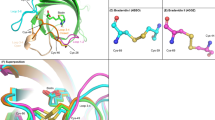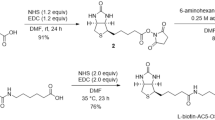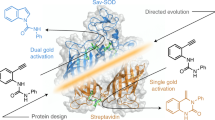Abstract
The ability to produce specific Streptavidin conjugates has been considerably enhanced by using a Streptavidin mutant containing a cysteine stretch, in which sulfhydryl groups serve as unique conjugation sites. A Streptavidin molecule containing five cysteine residues at its C-terminus, referred to as Stv-28, was efficiently expressed in Escherichia coli, and purified to homogeneity. Purified Stv-28 had full biotin-binding ability and formed a subunit tetramer. Reactive sulfhydryl groups of Stv-28, derived solely from the cysteine stretch, greatly facilitate the specific conjugation of partner molecules to Streptavidin by simple sulfhydryl chemistry. In this manner, S-[14C]carboxymethylated Streptavidin and a streptavidin-fluorescein conjugate were prepared. These conjugates contain almost twenty [14C]carboxymethyl groups and fluorescein molecules, respectively, per subunit tetramer, indicating that the sulfhydryl groups of the cysteine stretch are fully reactive. More importantly, these conjugates retain full biotin-binding ability and form subunit tetramers, suggesting that the fundamental properties of Streptavidin would be unaffected by the conjugation of other partner molecules to the C-terminal cysteine stretch.
This is a preview of subscription content, access via your institution
Access options
Subscribe to this journal
Receive 12 print issues and online access
$209.00 per year
only $17.42 per issue
Buy this article
- Purchase on Springer Link
- Instant access to full article PDF
Prices may be subject to local taxes which are calculated during checkout
Similar content being viewed by others
References
Bayer, E.A. and Wilchek, M. 1980. The use of the avidin-biotin complex as a tool in molecular biology. Methods Biochem. Anal. 26: 1–46.
Fuccillo, D.A. 1985. Application of the avidin-biotin technique in microbiology. BioTechniques 3: 494–501.
Wilchek, M. and Bayer, E.A. 1988. The avidin-biotin complex in bioanalytical applications. Anal. Biochem. 171: 1–32.
Wilchek, M. and Bayer, E.A. 1990. Avidin-biotin technology. Methods Enzymol. 184: 5–13
Wilchek, M. and Bayer, E. A. 1990. Applications of avidin-biotin technology: Literature survey. Methods Enzymol. 184: 14–45.
Chaiet, L., Miller, T.W., Tausing, F. and Wolf, F.J. 1963. Antibiotic MSD-235. II. Separation and purification of synergistic components. Antimicrob Agents Chemother. 3: 28–32.
Chaiet, L. and Wolf, F.J. 1964. The properties of streptavidin, a biotin-binding protein produced by Streptomvcetes. Arch. Biochem. Biophys. 106: 1–5.
Green, N.M. 1975. Avidin. Adv. Prot. Chem. 29: 85–133.
Green, N. M. 1990. Avidin and streptavidin. Methods Enzymol. 184: 51–67.
Sano, T. and Cantor, C.R. 1990. Expression of a cloned streptavidin gene in Escherichia coli Proc. Natl. Acad. Sci. U.S.A. 87: 142–146.
Sano, T. and Cantor, C.R. 1991. Expression vectors for streptavidin-containing chimeric proteins. Biochem. Biophys. Res. Commun. 176: 571–577.
Sano, T. and Cantor, C.R. 1991. A streptavidin-protein A chimera that allows one-step production of a variety of specific antibody conjugates. Bio/Technology 9: 1387–1381.
Sano, T., Glazer, A.N. and Cantor, C.R. 1992. A streptavidin-metallothionein chimera that allows specific labeling of biological materials with many different heavy metal ions. Proc. Natl. Acad. Sci. U.S.A. 89: 1534–1538.
Argaranña, C.E., Kuntz, I.D., Birken, S., Axel, R. and Cantor, C.R. 1986. Molecular cloning and nucleotide sequence of the streptavidin gene. Nucl. Acids Res. 14: 1871–1881.
Hendrickson, W.A., Pähler, A., Smith, J.L., Satow, Y., Merritt, E.A. and Phizackerley, R.P. 1989. Crystal structure of core streptavidin determined from multiwavelength anomalous diffraction of synchrotron radiation. Proc. Natl. Acad. Sci. U.S.A. 86: 2190–2194.
Weber, P.C., Ohlendorf, D.H., Wendroski, J.J. and Salemme, F.R. 1989. Structural origins of high-affinity biotin binding to streptavidin. Science 243: 85–88.
Studier, F.W. and Moffatt, B.A. 1986. Use of bacteriophage T7 RNA poly-merase to direct selective high-level expression of cloned genes. J. Mol. Biol. 189: 113–130.
Studier, F.W., Rosenberg, A.H., Dunn, J.J. and Dubendorff, J.W. 1990. Use of T7 RNA polymerase to direct expression of cloned genes. Methods Enzymol. 185: 60–89.
Hofmann, K., Wood, S.W., Brinton, C.C., Montibeller, J.A. and Finn, F.M. 1980. Iminobiotin affinity columns and their application to retrieval of streptavidin. Proc. Natl. Acad. Sci. U.S.A. 77: 4666–4668.
June, C.H., Ledbetter, J.A., Linsley, P.S. and Thompson, C.B. 1990. Role of the CD28 receptor in T-cell activation. Immunol. Today 11: 211–216.
Ljungquist, C., Jansson, B., Moks, T. and Uhlén, M. 1989. Thiol-directed immobilization of recombinant IgG-binding receptors. Eur. J. Biochem. 186: 557–561.
Kurzban, G.P., Bayer, E.A., Wilchek, M. and Horowite, P.M. 1991. The quatenary structure of streptavidin in urea. J. Biol. Chem. 266: 14470–14477.
Ito, T., Smith, C.L. and Cantor, C.R. Sequence-specific DNA purification by triplex affinity capture. Proc. Natl. Acad. Sci. U.S.A. 89: 495–498.
Ito, T., Smith, C.L. and Cantor, C.R. 1992. Affinity capture electrophoresis for sequence-specific DNA purification. Genetic Analysis: Techniques and Applications. In press.
Sanger, F., Nicklen, S and Coulson, A.R. 1977 DNA sequencing with chain-terminating inhibitors.Proc. Natl. Acad. Sci. U.S.A. 74: 5463–5467.
Sambrook, J., Fritsch, E.F. and Maniatis, T. 1989. Molecular Cloning: A Laboratory Manual, 2nd ed. Cold Spring Harbor Laboratory Press, Cold Spring Harbor, NY.
Kyhe-Andersen, J. 1984. Electroblotting of multiple gels: a simple apparatus without buffer tank for rapid transfer of proteins from polyacrylamide to nitrocellulose. J. Biochem. Biophys. Methods 10: 203–209.
Wei, R.-D. 1970. Assay of avidin. Methods Enzymol. 18A: 424–427.
Laemmli, U.K. 1970. Cleavage of structural proteins during the assembly of the head of bacteriophage T4. Nature 227: 680–685.
Author information
Authors and Affiliations
Rights and permissions
About this article
Cite this article
Sano, T., Smith, C. & Cantor, C. A Streptavidin Mutant Containing a Cysteine Stretch That Facilitates Production of a Variety of Specific Streptavidin Conjugates. Nat Biotechnol 11, 201–206 (1993). https://doi.org/10.1038/nbt0293-201
Received:
Accepted:
Issue Date:
DOI: https://doi.org/10.1038/nbt0293-201



